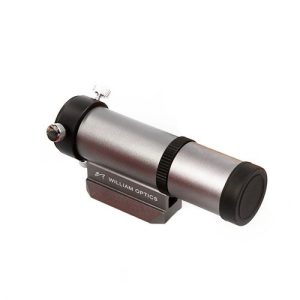The William Optics SpaceCat 61 WIFD is a limited edition offering of the popular William Optics 61mm apo astrograph offered in a unique space grey color combination.
 The limited edition SpaceCat 61 package includes:
The limited edition SpaceCat 61 package includes:
– SpaceCat 61 APO WIFD
– William Optics lens cap with Bahtinov mask
– Saddle Handlebar
– Camera Angle Rotator
– Tilt Adapter
– Mounting Rings
– Vixen Style Dovetail Plate
– William Optics UniGuide Slide-Base 32mm Guide Scope
The William Optics SpaceCat 61 WIFD offers high-quality optics with 4 elements in 3 groups (2-1-1- configuration). It is designed with FPL-53 glass up front, a single central element, and a single rear lens to provide a flat image plane without any need for an additional flattener. The Ohara FPL53 synthetic fluorite glass is used in a Petzval arrangement which makes this a quadruplet refractor. Being apochromatic, this telescope has almost zero chromatic aberration and delivers a flat field, even in full-frame.
The SpaceCat 61 comes with the William Optics Internal Focus Design (WIFD) where the movement of the focuser is integrated inside the main tube assembly providing the benefits of a traditional two speed fine focuser, while not worrying about limitations typically found in traditional rear mounted focusers. The WIFD design includes the patented William Optics center focuser with precise internal sliding of fixed optics to prevent image shift. The integrated position viewing window on the focuser provides instant verification of the graduated numerical display.
The smooth rack and pinion design is incorporated into the focuser to provide super fine adjustability for critical focus. The internal movement of the optical elements is protected from the elements and can’t come out of alignment. The redistribution of weight allows for better balance during imaging sessions.
The William Optics SpaceCat 61 WIFD specifications include:
– Focal Ratio: f/4.9
– Optical Design: Refractor
– Telescope Aperture: 61mm (2.4″)
– Focal Length: 300 mm
– Image Circle: 46mm Full Frame
– Focuser: William Optics WIFD
– Optical Tube Assembly Material: Aluminum
– Telescope OTA Outside Diameter:11.45in
– Dew Shield Diameter: 3.62in
– OTA Weight: 5.43lb
– OTA Length Extended: 14.37in
The William Optics SpaceCat 61 WIFD limited edition package includes a matching space gray William Optics UniGuide Slide-Base 32mm Guide Scope that features an anodized non removable Vixen/Synta-style rail at the bottom of the finder tube for direct insertion on the SpaceCat 61.
 The UniGuide has a focal length of 120 mm and a focal ratio of f/3.75. The back of the UniGuide scope comes with an M42 thread for attaching 1.25″ cylindrical-type guide cameras such as QHY, SBIG, and ZWO cameras. Tightening knobs will ensure a stable fit for the attached guiding equipment.
The UniGuide has a focal length of 120 mm and a focal ratio of f/3.75. The back of the UniGuide scope comes with an M42 thread for attaching 1.25″ cylindrical-type guide cameras such as QHY, SBIG, and ZWO cameras. Tightening knobs will ensure a stable fit for the attached guiding equipment.
The UniGuide has a full length of 147 mm. Of that length, the lens to the back of the guide scope is 105 mm. The Vixen slide-base measures 73 mm in length. The body of the guide scope comes with an adjustable distance of up to 25 mm. The design of the body even has a clever focus mechanism where to focus the guide scope, you only need to twist the built-in dew shield. Once you have your desired focus, then you can lock it in with the black ring at the base of the dew-shield.
The UniGuide Slide-Base 32mm Guide Scope features include:
– Aperture: 32 mm
– Focal Ratio: f/3.75
– Focal Length: 120 mm
– Weight: 0.529 lb. (0.24 kg)
– Guide Camera Thread: M42
– Camera Adapter Size: 1.25″
– Sliding Base: Vixen Style
– Guide Scope Length: 147 mm
– Adjustable Backfocus: 0~25 mm
You can learn more about the William Optics SpaceCat 61 WIFD limited edition here.
And to make it easier for you to get the most extensive news, articles and reviews that are only available in the magazine pages of Astronomy Technology Today, we are offering a 1-year magazine subscription for only $6! Or, for an even better deal, we are offering 2 years for only $9. Click here to get these deals which only will be available for a very limited time. You can also check out a free sample issue here.
The Sun is more active than it’s been in years and if that’s not enough, we have the upcoming Total Solar Eclipse on April 8, 2024! If you’d like to learn more about the technology behind solar observing, solar imaging and more, you can check out our new monthly magazine – Solar Astronomy Today. It’s free to read, no subscription needed and available here. And if you are preparing for the upcoming eclipses and want to know your equipment options from solar glasses to the most out of this world solar viewing and imaging options, check out our free publication – The Definitive Guide to Viewing and Imaging the Sun – simply click here and enjoy reading!



